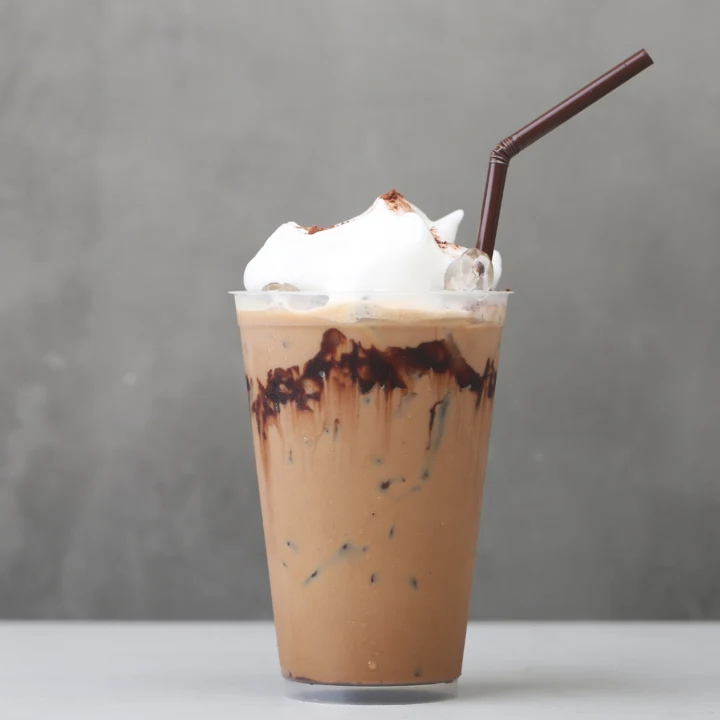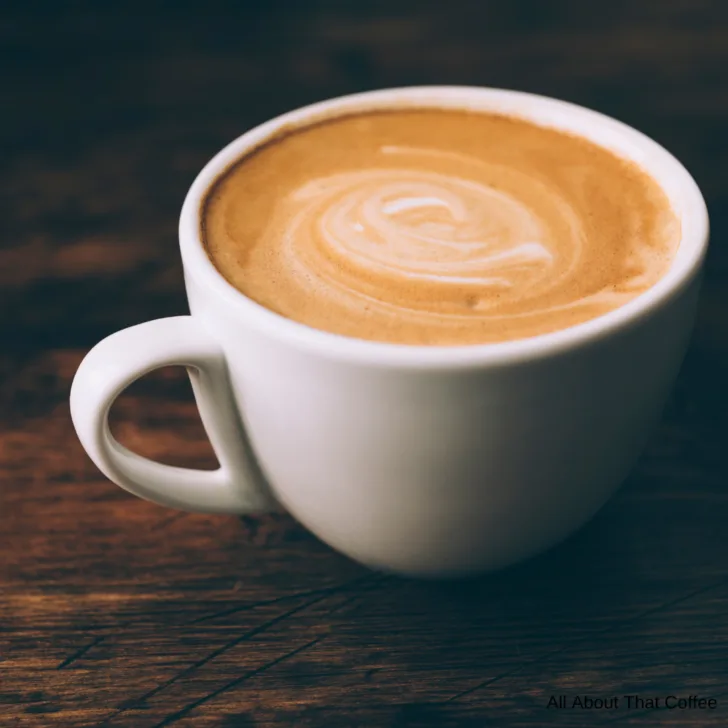Table of Contents
What’s the difference between a frappe vs latte? How do you make them? Which one is better? Do you know? If not, don’t worry – you’re about to find out!
In this blog post, we’re going to compare frappes and lattes. We will outline the key differences between the two drinks, as well as how to make each one.
By the end of this article, you will be able to impress your friends and family with your newfound knowledge of frappés and lattes!
What is a frappe?

A frappe, often pronounced “frap-pay,” is a delightful, frothy, and refreshing beverage that typically consists of instant coffee blended with ice, sugar, milk, or water, and various flavorings, such as chocolate, or fruit syrups.
The icy mixture is then poured into a glass and usually topped with whipped cream or a dusting of cocoa powder or cinnamon.
While the term “frappe” has become synonymous with cold and creamy drinks, its origins and variations can be traced back to different cultures and traditions.
Frappe’s Journey
The frappe’s journey began in the Mediterranean region, specifically in Greece, during the 1950s.
Nestlé employee Dimitris Vakondios was attending the International Trade Fair in Thessaloniki, Greece when he inadvertently created the first-ever coffee frappe.
In an attempt to make an instant coffee, Vakondios used a shaker instead of available hot water, resulting in a cold, frothy concoction.
This serendipitous experiment went on to become the Greek frappe – a popular summertime drink consisting of instant coffee, water, sugar, and ice cubes, often served with a touch of evaporated milk.
Over time, the frappe became popular not only in Greece but also in several European countries, eventually reaching the United States.
Evolution of the Frappe
The concept quickly evolved and integrated into numerous coffee chains and cafés around the world, especially adapting to the tastes of the burgeoning iced coffee market.
As various cultures and regions put their spin on the frappe, more innovative ingredients and presentations surfaced.
For instance, the New England frappe in the United States is essentially a milkshake with ice cream. Whereas the frappé coffee in the UK and Cyprus refers to a cold, blended coffee drink similar to its Greek predecessor.
Apart from its geographical variations, the frappe has also traversed different culinary contexts.
Frappes come in a wide array of flavors, including fruity options like strawberry, raspberry, and mango as well as indulgent confections such as caramel and chocolate.
Furthermore, frappes cater to diverse dietary preferences, with milk substitutes like almond, soy, or oat milk making the drink suitable for vegans and lactose-intolerant individuals.
In conclusion, the frappe has a rich history stemming from its humble Greek origins to the international variations that exist today.
Regardless of the ingredients or location, the frappe remains a beloved beverage that brings respite on a hot day and offers a moment of indulgence for dessert lovers around the world.
With its alluringly frothy texture and a vast selection of flavors, the frappe continues to captivate palates and evolve as a versatile and delectable drink.
What is a latte?

A latte, on the other hand, is a hot coffee beverage that originated in Italy.
Formally known as a caffè latte, it is a popular coffee beverage featuring a delightful combination of espresso and steamed milk, often topped with a thin layer of foam.
The term “latte” stems from the Italian phrase “caffè e latte,” which translates to “coffee and milk” in English. This harmonious blend of bold espresso and velvety milk creates a rich and creamy flavor profile. This makes the latte a favored choice for coffee enthusiasts worldwide.
Latte’s Origins
The origins of the latte can be traced back to Europe, specifically Italy, where the tradition of combining coffee with milk has been a longstanding practice.
This custom is believed to have emerged in the 17th century when Europeans were introduced to coffee by traders from the Ottoman Empire. The tradition evolved, with different cultures across Europe developing their versions of coffee and milk beverages.
For instance, in France, the “café au lait” became a prevalent choice, while in Spain, “café con leche” became popular.
It is worth noting that the concept of adding milk to coffee was not exclusive to Europe. In fact, several instances of milk and coffee mixtures can be found in different regions of the world.
For example, the Viennese “melange,” Ethiopian “macchiato,” and Indian “beaten coffee” all incorporate milk with coffee in unique ways.
Regardless of these global variations, the caffè latte is widely associated with the Italian coffee tradition and is often considered a cornerstone of Italian coffee culture.
Evolution of the Latte
The modern espresso-based latte we know today began to take shape in the 20th century. Advancements in espresso machines enabled the creation of the perfect balance between espresso and steamed milk.
The introduction of the steam wand in espresso machines revolutionized the process of frothing milk. Steamed milk provides a velvety, silky texture that has become the hallmark of a well-crafted latte.
The latte expanded beyond the borders of Italy and Europe, reaching the United States in the 1980s.
Particularly in Seattle, it became an integral part of the burgeoning specialty coffee scene, with innovators such as Starbucks introducing the beverage to a larger audience.
This crucial period in the American coffee movement, frequently referred to as the “Second Wave” of coffee, led to the widespread popularity of espresso-based drinks, and the latte became one of the most highly sought-after beverages in cafes across the nation.

In contemporary times, the latte’s appeal has spurred creativity among baristas, with the advent of latte art and the use of alternative milk options, such as almond, soy, and oat milk.
Through continuous innovation and adaptation, the latte remains a beloved coffee classic that has stood the test of time, entwining itself into the very fabric of global coffee culture.
Frappe vs Latte: The Key Differences
Now that we know what a frappe and latte are let’s take a closer look at the key differences between these two popular coffee drinks.
Temperature
When considering the distinction between a frappe vs latte, the temperature is arguably the most prominent factor.
Frappes are chilled to offer refreshment in hot climates or seasons. Lattes, on the other hand, provide comforting warmth for those seeking coziness.
Whether you’re looking for an energizing pick-me-up or soothing relief from cold temperatures, there’s no denying that these two beverages have got you covered!
Ingredients
An additional noteworthy distinction between frappe vs latte lies in the ingredients used to make them.
Frappes are typically composed of instant coffee, milk, sugar, and ice. Lattes have espresso as their foundation ingredient alongside steamed milk with a light foam topping.
This discrepancy in components provides each drink its own unique flavor profile as well as texture.
Texture
Frappes boast a creamy, frothy consistency with a silky smooth texture. On the other hand, lattes are noted for their velvety feel thanks to steamed milk.
The type of dairy used in making lattes – such as whole milk, skimmed milk, or almond milk – can also affect its texture and taste.
Caffeine Content
There is a stark difference between the caffeine content of frappes and lattes. Generally, frappes contain less caffeine since they are made using instant coffee rather than espresso-based shots.
Nevertheless, some cafes may opt to use double or triple shots in their lattes instead; thus making them even higher in caffeine than a normal frappe would be.
Frappe vs Latte: Who Wins?
Ultimately, the decision between frappe vs latte comes down to personal preference. Whether you’re on the hunt for a more classic espresso-based option or something more playful and energizing, there’s sure to be a beverage that meets your needs!
Both drinks have their own unique flavor profiles as well as textures; it just boils down to which one suits you best in the moment. If you want to experiment, why not try both? You may just find that they are equally as delicious!
At the end of the day, there’s no wrong or right choice between frappe vs latte – it all comes down to individual taste. So if you’re in the mood for a delicious cup of cold or hot coffee, both have something special to offer!
The definitive answer to frappe vs latte is that there is no definitive answer – it all comes down to personal preference. Both drinks provide their own unique flavor and texture profiles, so why not indulge in both?
How to Make a Frappe
Making a frappe at home is quick and easy. Here is a simple recipe for a classic frappe.
Ingredients:
- 1 teaspoon instant coffee
- 1 cup milk
- 1 tablespoon sugar
- 1 cup ice cubes
Instructions:
- Add the instant coffee, milk, and sugar to a blender.
- Blend the ingredients on high speed until the mixture is frothy and smooth.
- Add the ice cubes to the blender and blend on high speed until the ice is crushed and mixed in with the other ingredients. Pro-tip: Use coffee ice cubes, so you don’t dilute the drink.
- Pour the frappe into a tall glass and serve with a straw.
You can also experiment with different flavors and toppings for your frappe, such as chocolate syrup, whipped cream, or caramel sauce.
How to Make a Latte
Making a latte at home requires a little more skill and equipment than making a frappe, but it is still doable. Here is a recipe for making a classic latte at home.
Ingredients:
- 1-2 shots of espresso
- 1 cup milk
- Sugar (optional)
Instructions:
- Start by brewing your espresso using an espresso machine. If you don’t have an espresso machine, you can use a stovetop espresso maker or a French press to make a concentrated coffee.
- While the espresso is brewing, heat up the milk in a small saucepan or a milk frother. Heat the milk until it is steaming hot but not boiling.
- Once the milk is heated, use a milk frother to froth the milk, creating a velvety and silky texture. If you don’t have a frother, you can use a whisk or a blender to froth the milk manually.
- Add sugar to the milk if desired and stir until it dissolves.
- Pour the espresso shot into a coffee mug and then slowly pour the steamed milk over the espresso.
- Spoon the frothed milk over the top of the latte, creating a small layer of foam on top.
- Serve immediately and enjoy.
Just like frappes, lattes can also be customized with different flavors and toppings. You can add syrups, spices, or whipped cream to your latte for an extra flavor boost.
Conclusion
In summary, frappes and lattes are two popular coffee drinks with different flavor profiles, textures, and preparation methods.
Frappes are cold and refreshing beverages made with instant coffee, milk, sugar, and ice, while lattes are hot and comforting drinks made with espresso, steamed milk, and a small layer of frothed milk.
Both drinks can be customized with various flavors and toppings, making them versatile beverages for coffee lovers.
Whether you prefer a cold and frothy frappe or a hot and velvety latte, these drinks are a delicious way to enjoy your daily caffeine fix!
Happy brewing! Happy sipping!
P.S. Be sure to check out our other coffee-related articles for more information, as well as more tips and tricks on making the perfect cup of joe and to learn “All About That Coffee!”

